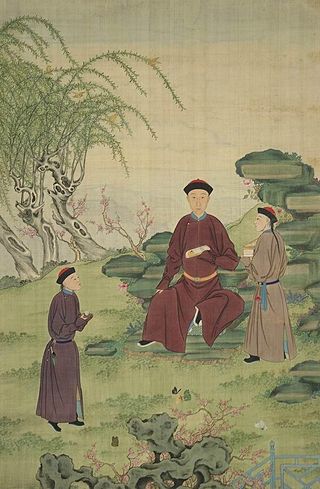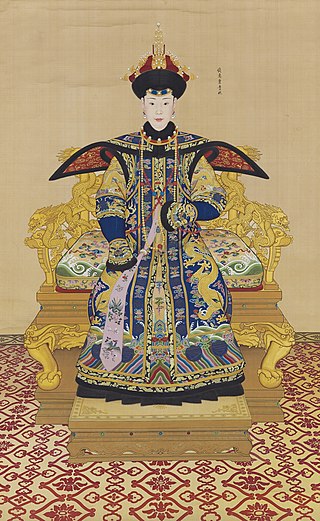This article has multiple issues. Please help improve it or discuss these issues on the talk page . (Learn how and when to remove these template messages)
|
Uya (Manchu: ᡠᠶᠠ
ᡥᠠᠯᠠ ; Chinese :烏雅氏) was a clan of Manchu nobility.
This article has multiple issues. Please help improve it or discuss these issues on the talk page . (Learn how and when to remove these template messages)
|
Uya (Manchu: ᡠᠶᠠ
ᡥᠠᠯᠠ ; Chinese :烏雅氏) was a clan of Manchu nobility.
| Date | Prince Consort | Background | Princess |
|---|---|---|---|
| 1772 | Jalantai (札蘭泰/札兰泰; d. 1788) | Princess Heke (1758–1780), the Qianlong Emperor's ninth daughter by Empress Xiaoyichun (Weigiya) |
Imperial Consort
Princess Consort


The Daoguang Emperor, also known by his temple name Emperor Xuanzong of Qing, personal name Mianning, was the seventh emperor of the Qing dynasty, and the sixth Qing emperor to rule over China proper, reigning from 1820 to 1850. His reign was marked by "external disaster and internal rebellion." These included the First Opium War and the beginning of the Taiping Rebellion which nearly brought down the dynasty. The historian Jonathan Spence characterizes the Daoguang Emperor as a "well meaning but ineffective man" who promoted officials who "presented a purist view even if they had nothing to say about the domestic and foreign problems surrounding the dynasty."

The Jiaqing Emperor, also known by his temple name Emperor Renzong of Qing, personal name Yongyan, was the sixth emperor of the Manchu-led Qing dynasty, and the fifth Qing emperor to rule over China proper, from 1796 to 1820. He was the 15th son of the Qianlong Emperor. During his reign, he prosecuted Heshen, the corrupt Manchu favorite of his father, and attempted to restore order within the Qing Empire while curbing the smuggling of opium into China.

The Niohuru were a prominent Manchu clan during the Qing dynasty. The clan had inhabited the Changbai Mountains since as early as the Liao dynasty. The clan was well known during the Qing dynasty for producing a variety of consorts of all ranks for emperors, several of whom went on to become mothers to reigning emperors. Prominent people who belonged or trace heritage to the Niohuru clan including famed Manchu warrior Eidu, his son the high official Ebilun, the Empress Dowager Ci'an, the infamous corrupt official Heshen, the contemporary concert pianist Lang Lang and Lang Tsuyun, Taiwanese TV, movie and stage actress, singer and producer.

Yixuan, formally known as Prince Chun, was an imperial prince of the House of Aisin-Gioro and a statesman of the Manchu-led Qing dynasty in China. He was the father of the Guangxu Emperor, and the paternal grandfather of Puyi through his fifth son Zaifeng.
Gūwalgiya was one of the most powerful Manchu clans. It is often listed by historians as the first of the eight prominent Manchu clans of the Qing dynasty. After the demise of the dynasty, some of its descendants sinicized their clan name to the Han Chinese surname Guan (關).
Tunggiya is the name of a Manchu clan.

Hongzhou, formally known as Prince He, was a Manchu prince of the Qing dynasty.

Empress Xiaogongren, of the Manchu Plain Yellow Banner Uya clan, was a posthumous name bestowed to the consort of Xuanye, the Kangxi Emperor and mother of Yinzhen, the Yongzheng Emperor. She was honoured as Empress Dowager Renshou during the reign of her son and posthumously honoured as empress, although she never held the rank of empress consort during her lifetime.

Empress Xiaoyichun, of the Manchu Bordered Yellow Banner Weigiya clan, was a consort of the Qianlong Emperor. She was 16 years younger than him. Her eldest surviving son became the Jiaqing Emperor.

Imperial Noble Consort Chunhui, of the Han Chinese Plain White Banner Su clan, was a consort of the Qianlong Emperor. She was two years his junior.

Noble Consort Xin, of the Manchu Bordered Yellow Banner Daigiya clan, was a consort of the Qianlong Emperor. She was 26 years his junior.

Nara is a clan name shared by a number of royal Manchu clans, sometimes also transliterated as Nalan or Nalland. The four tribes of the Hūlun confederation (扈倫四部) – Hada, Ula, Hoifa and Yehe – were all ruled by clans bearing this name.
The Qing dynasty (1636–1912) of China developed a complicated peerage system for royal and noble ranks.
Fuca was a clan of Manchu nobility. After the demise of the dynasty, some of its descendants sinicized their clan name to the Chinese surnames Fu (富/傅) or Li (李).
Tatara was a clan of Manchu nobility. After the demise of the dynasty, some of its descendants sinicized their clan name to the Chinese surnames Tang (唐), Tan (譚), Shu (舒) or Song (松).

Imperial Noble Consort Dunyi was a consort of Kangxi Emperor. She was 29 years his junior. She outlived Empress Xiaoxianchun, the Hoifa-Nara Step Empress, and several Qianlong's consorts and children.
Concubine Yi, of the Han Chinese Booi Aha of Plain Yellow Banner, was a consort of Qianlong Emperor.
Daoguang Emperor had fifteen consorts, including four empresses, one imperial noble consort, three noble consorts, three consorts and four concubines.
Sirin Gioro was a clan of the Manchu nobility, one of the prominent Gioro family. The other clans of Gioro Hala were Aisin Gioro (爱新觉罗), the ruling clan from 1616 to 1912, Irgen Gioro (伊尔根觉罗) and Šušu Gioro (舒舒觉罗). The clan belonged to the Bordered Blue Banner. The clan members inhabited the area ranging from Nimaca, Hoifa, Changbai Mountains, Jianzhou, Ningguta and Hada
Donggo was a clan of Manchu nobility belonging to the Manchu Plain White Banner, one of the 3 upper banners of Eight Banner system. Several lineages were members of Manchu Plain Red Banner.